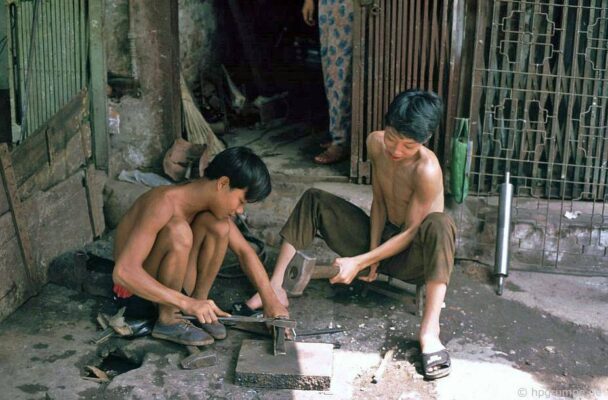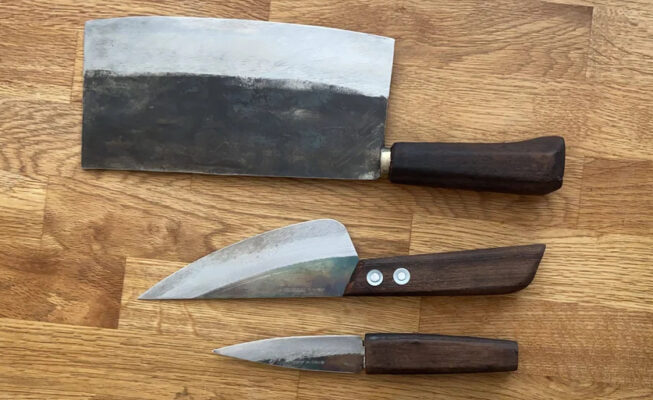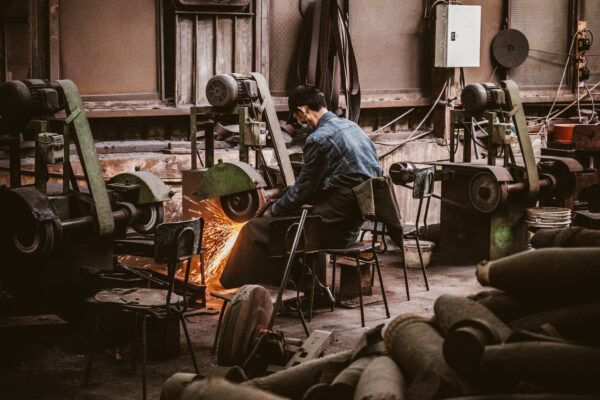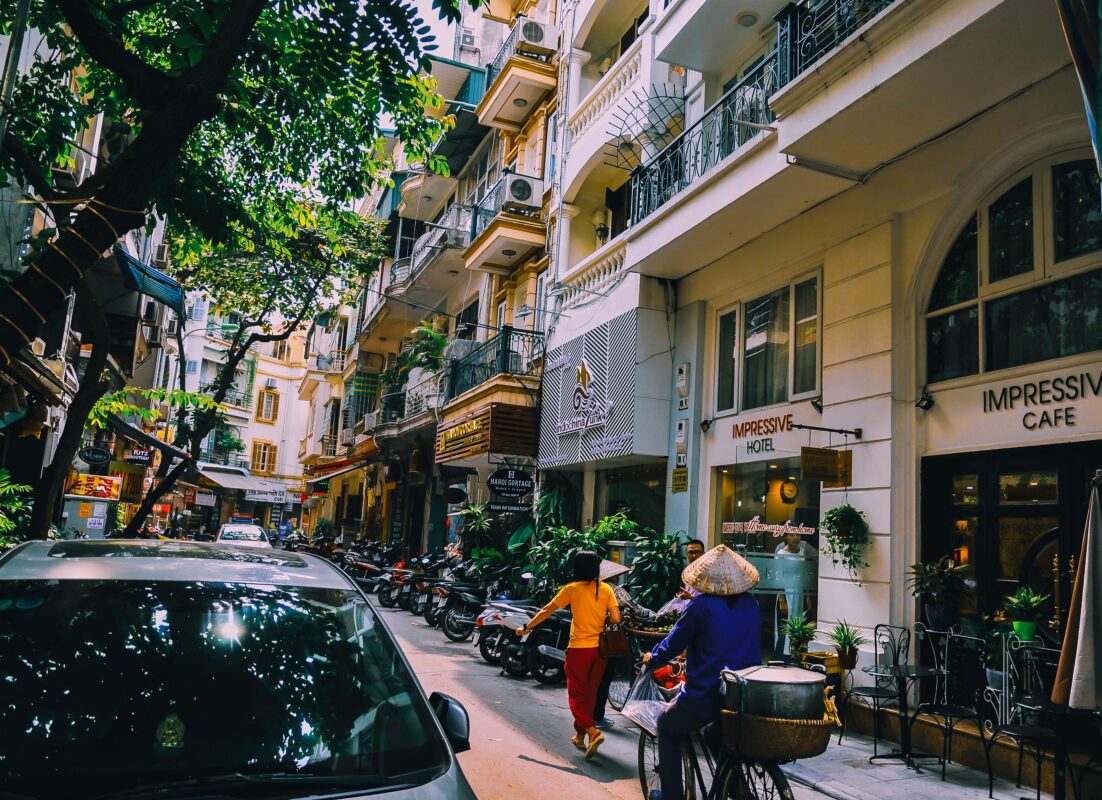A look at how kitchen knives are made in Vietnam
TYPEMYKNIFE®, specialist in European kitchen knives, was in Vietnam a few years ago. A dream destination. Incredibly friendly people, impressive nature.
But what impressed us the most were the many craftsmen who were still at work in the narrow, busy streets at night. We were most interested in the blacksmiths. They squatted in front of a small anvil that didn’t reach their knees and performed real miracles on it.
Made from old steel, mostly truck coil springs. Bought cheaply from scrap metal collectors, they created everyday objects in their meager workshop with the simplest means, hammer and pliers.
The family was gathered around the embers. They cooked on the floor and children played. Pure life.

That’s exactly the romantic colonial tourist’s point of view on things, which we also fell for.
The reality is different. Since the value of the workshops on the shopping streets is measured by their width, people live in narrow, almost tube-like rooms. The light comes from the street, behind it it quickly gets dark. The hygienic conditions are bad.
A factory worker in Vietnam earns around $150 a month, depending on the economic zone. Depending on the business situation, a craftsman earns significantly less. The difference to the country is enormous. The incomes there are marginal.
Poor working conditions in Vietnam have long been the subject of international criticism. Global corporations are accused of locking up women workers and forcing them to work overtime. Protective measures on machines. Sprinkler systems and escape doors are usually not functional. The list would be too long to cover all abuses.
As for the minimum wage, it has to be low if Chinese and Indian companies produce in Vietnam and thus save costs.
We remembered all this when we saw advertisements for Vietnamese knives on the internet.

The usefulness of these knives is fundamentally questionable
It’s not for nothing that European knives are drop-forged from stainless steel and therefore equipped with a bolster that protects the handle from mechanical stress and moisture.
The shape of the European knife has evolved over the centuries in line with our eating habits.
The whole design and construction is made to bring our local raw materials into the form that we use in our kitchen.
Asian knives come from a completely different tradition. Meat and fish are divided there differently and made into pieces.
Vegetables are prepared very differently in other forms. In this way, Asian knives also meet the needs of other cooking habits.
There’s a good reason why European cooking prefers drop-forged bolster knives. In the Asian knife tradition, the blades are forged very simply and flat.
They have a flat blade that protrudes flat in the tang. This tang is inserted into a wooden handle and glued.
In order to give the handle stability in the front area against mechanical wear and contact with steam, water and moisture, a metal ferrule is often placed over the wooden handle.
The new hype about carbon steel for kitchen knives
Carbon steel, a rediscovered type of steel for knives or old wine in new skins?
Carbon steel was the only steel alloy before it was refined into stainless steel.
Yes, carbon steel is harder than stainless steel. But that never outweighs all the advantages of our modern stainless steels. It is not for nothing that our high-quality chrome vanadium steel has not only established itself in the kitchen, cooking and dining area.
Carbon steel rusts. It can be argued that lots of ongoing care may prevent rusting. But it rusts again after each use.
Oiling helps against this. Clear. But you have this oil back on the clippings the next time you cut. Or you don’t oil. Then your toast will turn red from the rust film when you cut it with the carbon steel.
Or you don’t oil. Then your white bread will turn red from the flash rust when you cut it with the carbon steel. Discolouration occurs particularly when cutting fruit.
Coming back to the Vietnamese knives on the web.
These are left raw after forging. This means that the black layer of scale remains on the blade where it has not been sharpened.
Scale is black iron oxide. That gives a nice contrast. Unfortunately also on the freshly cut fruit or vegetables.
Because tinder is attacked by the fruit acids. This discolors your beautiful carbon design knife and what you are cutting.
Finally, the tinder is in the jam and the stains on the knife.

Kitchen knives in the wake of greenwashing and social glorification
What is presented and sold to us on the Internet is a tearful eco-social fairy tale for maximum profit.
Vietnamese knives sustainably produced by poor farmers and with my purchase I save the family from starvation. At the same time, make a valuable contribution to the environment, ecology and sustainability.
This may be a good advertising strategy, but it infamously idealizes reality. Those who produce bad goods in Asia win twice.
The raw materials are cheap, the labor is cheap. Bringing these goods to the European market here promises good profits. Even higher profits can be achieved if the buyer is fooled into thinking they are doing something good.
The customer becomes a supporter of the craftsmen, their families and the entire village community. The raw materials are old beams steeped in history, leaf springs and saw blades.
This makes it exotic and sold to us as organic and sustainable. I mainly see cheap material purchases.
How is the Japanese blade design doing in Vietnam?
Japanese knives are very popular in Europe. Japan developed the hardest steels and the most beautiful damasks.
The knife and sword tradition is long and rich in history. The quality of high-quality, hand-forged knives with inserted blades is in no way inferior to European knives.
But why are there Vietnamese knives with Japanese designs now? This can only be a marketing strategy.
Economical shopping with reference to handmade and recycled material. But Vietnamese design doesn’t seem to be good enough.
That would be authentic and a tribute to the dedicated eco-sustainable producers out there.
Japanese is doing better at the moment, especially since large and well-known knife companies and dealers have created this image in Europe with a lot of effort.
Relying on Japanese design with Vietnamese knives is more like free-riding.
Our respect and admiration for the artisans of Vietnam.
People, mostly teenagers and children in the production process, who make kitchen knives with the smallest of means, deserve our greatest respect.
Products that are manufactured without any safety standards and with great danger to body and soul should not become a pawn in our financial interests.
For this reason, we at TYPEMYKNIFE® have decided to only offer kitchen knives made in Europe.
These correspond to our high ecological and socio-economic safety standards.
Tradition and modernity handcrafted by European manufacturers at TYPEMYKNIFE®

